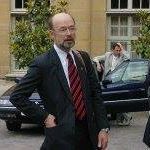Unpublished Opinions
A former federal civil servant (Foreign Affairs) and consultant, Terrence Lonergan lives in Ottawa and is active in local and community affairs.
A Modern Library for Ottawa (PART 3)

PART 3. The Modern Library is a Gateway to Total Reading
Over the last few days, I have submitted two short essays on Ottawa’s next Central Library. It is now time to deal with the third paradox that defines the Modern Library.
………………………
Paradox 3.
As the book-object disappears, its contents are freed, poised for a new and larger life.
Full digitization allows automated text search as well as instant access to and retrieval of any document in the collection. It becomes possible to explore books, delve into them, rather than simply read them, line-by-line, page after page. The traditional reader has to take the book as an entity, a whole but bounded experience. He flips open the cover, then fingers through the frontispiece and in a flash, he is immersed in the microcosm of a good story, a reality onto itself that blocks out all surrounding sounds and sights.
That’s the beauty but also limitation of reading from a book: one cannot at the same moment be inside and outside. Not even on the sidelines. Printed text restricts the reader to the narrow channel of the sentence, and reveals only what the author wished specifically to transmit or had time and space for in his book.
Non-fiction attempts to overcome these constraints by providing links to other books or websites in the form of footnotes and endnotes. An awkward procedure at best since it compels the reader to switch back and forth to the end of the volume, at the risk of losing his thought or place on the page. Then again, the true purpose of these links is not to propose a detour but more prosaically to demonstrate that the author has carefully carried out his research and presented the best information he could lay his hands on.
Lose the binding and the text is liberated. Each word, each sentence potentially becomes the springboard to a wider experience.
The contents of books were never anything else but information. Story telling was never more than just another type of communication. When a text is digitized and every word can be linked to anything else, inside or outside the story, the limitations of print jump, so to speak, right off the page.
This has useful applications, from the most basic fact checking (to ward off authors who play loose and fast with the facts in order to influence their reader or get him to share their beliefs), to the more rewarding having a look-see at what lies beyond the page.
Margaret Atwood, Mordecai Richler, Yann Martel, it doesn’t matter whom: each author injects into his writing a universe of ideas, feelings, beliefs, factual tidbits, all of which gives texture and depth to her or his book without ever being fully revealed.
- Wish to follow the track of Michael Ondaatje’s English Patient across North Africa and better understand the role he played in the war?
- Want to know about the 1440 Black Diner Alice Munro alludes to in The View from Castle Rock?
- Or understand why a beaded moccasin, a sweat lodge, or an eagle feather has special significance for Joseph Boyden or a Cree?[i]
Digitization puts the answer to any such question, no matter how complex or minute, literally at the reader’s fingertips, enables him and her to plumb the depth of their favourite author’s imagination. It opens the door to “Total Reading”.
This holds true for all authors; those long dead as much as those still busy scribbling words on paper or computer screen. The past is a huge repository of human life, knowledge and wisdom that we could only peer at through a keyhole called the book. Digitization can and should blow open the door.
In such a vivid encounter with the past, a century old author acquires the vividness, relief and detail of someone alive. The string of events she weaves into a story becomes more understandable because it is linked more directly to our every day, contemporary, life experience.
Just now, a question has formed in your mind: can’t I already do this, from home, simply by accessing the Internet?
Yes you might, provided you owned an electronic copy of the book plus a copy of all those you will need to cross-reference. The first condition is easy enough to meet. The second is near impossible, even for the super-rich.
It’s not a question of money but copyright.
The world of ideas and writings we inhabit does not resemble the prairies where grassland touches the sky and borders seem to melt in the horizon. No, it’s rather like a rice-paddy where every single tiny plot of land is tightly delineated by ditches and dams.
The cultural commons and the public domain, as the open regions are called, actually amount to a small chunk of the global universe of text, whether in print or electronic form.
In most instances, today, access to information and ideas is restricted, ‘paywalled’ as they say.
During the research for this essay, I undertook to survey the scholarly literature on the “modern library” and its challenges in order to inform myself of the current thinking and look over any ongoing discussion of the topic.
The result was far from satisfactory. Much of the open academic literature is out of date or pertains to developing countries for which, unfortunately, digitization lies far into the future.
Current academic articles on libraries in Europe or North America are kept in cages like exotic zoo animals. Apart from a short public summary, the contents are placed under lock and key. A janitorial corporation collects rent, with the author receiving, hopefully, his cut of the profits (in my limited experience, the stipend for surrendering my copyright was £ 1, which I never received).
The tragedy, of course, is that, once behind this barrier, an article loses a great part of its potential readership and fails to make the impact it merits. This can compel other authors to uselessly duplicate the original research. To make matters worse, hidden articles cannot be scanned by web-crawlers, which means that their Page-rank is kept low and they are unlikely to show up in the first pages of an Internet search.
Scientists, those in the hard sciences in particular, have rebelled against the corporate tendency to build enclosures because it chokes off the progress of science. Internet started as an information platform where scientists could freely share their research and insights. Unfortunately, for reasons beyond the scope of this essay, the World Wide Web has failed to develop into a universally accessible global information bank.
In these circumstances, it is of considerable importance that, in Canada, as in most advanced countries, libraries enjoy a form of a copyright exception. It’s a narrowly defined exception but it allows users to borrow books for free or a very modest fee. It also ensures that, at the library, the bulk of the collection is freely available for consultation (access to rare or historical documents, which are often delicate artefacts, is usually restricted to scholars or researchers who have a special interest in them).
As far as I can see, the Government of Canada has not yet fully addressed how e-books and electronic text (such as websites) are to be brought under the library copyright exception. The hardcopy precedent does imply that all electronic documents should equally be open to casual perusal at the Library.
Music in electronic form already follows similar rules: websites such as the CBC Internet radio, RDIO, and Spotify allow music streaming, free of charge, or for a nominal fee often paid in the form of inserted advertisement clips.
The educational role of libraries justifies a strong and widespread exemption from copyright. In addition, it makes good business sense to place e-books and other electronic documents under the Library exception. Private rights holders will gain an opportunity to make long-term revenues. Just like listening to free music on the radio or web, reading paper or electronic documents in a library is not only pleasureful but also wets the appetite for more. It activates the desire to build one’s private collection, Just one additional click, and the reader is visiting the local bookstore or shipping online from wholesalers like Chapters-Indigo, or from electronic publishers such as JSTOR, Wiley, or Sage.
It would not be difficult or controversial for Canada to amend its legislation so as to allow public libraries users to ‘Total Read’. A simple update of the library’s copyright exception would do it.
It would also help, of course, if an elegant yet simple piece of software were to automate the shift from normal to total reading. As you read from a screen, imagine that selecting a sentence or paragraph and dropping them in a box was sufficient to launch a search that would result, a fraction of a second, in the response to your implied request for background information. What a way to wander through an author’s headspace!
By facilitating total reading, libraries would enrich the reading experience and pleasure of their users and undoubtedly attract many more visitors, equally desirous to get more from their favourite book or author.
Libraries would also help us break old mental barriers; make us understand that any statement can serve as a launching pad to a new thought. At a time when imagination, creativity, and innovation are in key demand, because of their potential impact on society, why would anyone persist with plain old textual reading.
Terrence Lonergan
Ottawa
..........................
[i] The three books referred to are:
1. Ondaatje, Michael: The English Patient, Vintage Canada, Toronto (1993)
2. Muro, Alice: The View From Castle Rock, Douglas Gibson Books, Toronto (2006)
3. Boyden, Joseph: Three Day Road, Weidenfield & Nicholson, London (2005)
--------------------------
- PART 1. The Modern Library is also a Community Centre
- PART 2. The Modern Library Opens a Window into the Whole Written World
- PART 4. The Modern Library is also a Knowledge Factory
- PART 5. Ottawa's New Central Library: What for? What like? Where?



Comments
Be the first to comment